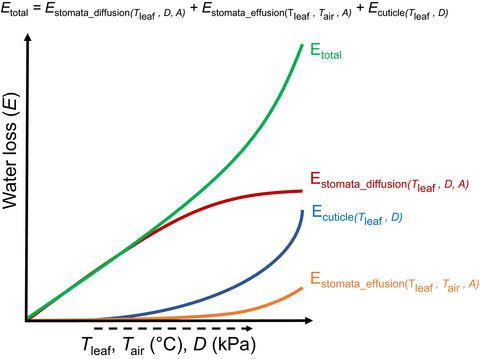当前位置:
X-MOL 学术
›
Ecol. Lett.
›
论文详情
Our official English website, www.x-mol.net, welcomes your
feedback! (Note: you will need to create a separate account there.)
High water use in desert plants exposed to extreme heat.
Ecology Letters ( IF 7.6 ) Pub Date : 2020-05-21 , DOI: 10.1111/ele.13516 Luiza M T Aparecido 1 , Sabrina Woo 1 , Crystal Suazo 1 , Kevin R Hultine 2 , Benjamin Blonder 1, 3, 4
Ecology Letters ( IF 7.6 ) Pub Date : 2020-05-21 , DOI: 10.1111/ele.13516 Luiza M T Aparecido 1 , Sabrina Woo 1 , Crystal Suazo 1 , Kevin R Hultine 2 , Benjamin Blonder 1, 3, 4
Affiliation

|
Many plant water use models predict leaves maximize carbon assimilation while minimizing water loss via transpiration. Alternate scenarios may occur at high temperature, including heat avoidance, where leaves increase water loss to evaporatively cool regardless of carbon uptake; or heat failure, where leaves non‐adaptively lose water also regardless of carbon uptake. We hypothesized that these alternative scenarios are common in species exposed to hot environments, with heat avoidance more common in species with high construction cost leaves. Diurnal measurements of leaf temperature and gas exchange for 11 Sonoran Desert species revealed that 37% of these species increased transpiration in the absence of increased carbon uptake. High leaf mass per area partially predicted this behaviour (r 2 = 0.39). These data are consistent with heat avoidance and heat failure, but failure is less likely given the ecological dominance of the focal species. These behaviours are not yet captured in any extant plant water use model.
中文翻译:

暴露于极热条件下的沙漠植物中水的大量使用。
许多植物用水模型预测叶片最大程度地吸收碳,同时最大程度地减少因蒸腾作用而造成的水分流失。在高温下(包括避免热)可能会发生其他情况,无论碳的吸收如何,叶片都会增加水分流失,从而蒸发冷却。或热衰竭,无论碳吸收如何,叶子都不适应地失水。我们假设这些替代方案在暴露于高温环境的物种中很常见,而避免热在具有较高建造成本的物种中更常见。对11个Sonoran沙漠物种的叶片温度和气体交换的昼夜测量表明,在没有增加碳吸收的情况下,其中37%的物种增加了蒸腾作用。每单位面积高叶片质量可部分预测这种行为(r 2 = 0.39)。这些数据与避免热和热失效相一致,但是考虑到焦点物种的生态优势,失效的可能性较小。这些行为尚未在任何现有的植物用水模型中捕获。
更新日期:2020-07-06
中文翻译:

暴露于极热条件下的沙漠植物中水的大量使用。
许多植物用水模型预测叶片最大程度地吸收碳,同时最大程度地减少因蒸腾作用而造成的水分流失。在高温下(包括避免热)可能会发生其他情况,无论碳的吸收如何,叶片都会增加水分流失,从而蒸发冷却。或热衰竭,无论碳吸收如何,叶子都不适应地失水。我们假设这些替代方案在暴露于高温环境的物种中很常见,而避免热在具有较高建造成本的物种中更常见。对11个Sonoran沙漠物种的叶片温度和气体交换的昼夜测量表明,在没有增加碳吸收的情况下,其中37%的物种增加了蒸腾作用。每单位面积高叶片质量可部分预测这种行为(r 2 = 0.39)。这些数据与避免热和热失效相一致,但是考虑到焦点物种的生态优势,失效的可能性较小。这些行为尚未在任何现有的植物用水模型中捕获。











































 京公网安备 11010802027423号
京公网安备 11010802027423号